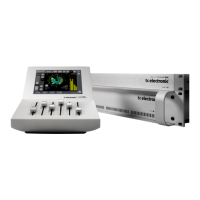114
lM6
Main page
Descriptor 1-2
Loudn. Range
LoudnessRange,standardizedinEBUR128and
abbreviated“LRA”,displaystheloudnessrangeofa
program,afilmoramusictrack.TheunitisLU,whichcan
bethoughtofas“dBontheaverage”.
The Loudness Range descriptor quantifies the variation of
the loudness measurement of a program. It is based on the
statistical distribution of loudness within a program, thereby
excluding the extremes. Thus, for example, a single
gunshot is not able to bias the LRA number.
EBUR128doesnotspecifyamaximumpermittedLRA.
R128 does, however, strongly encourage the use of LRA
to determine if dynamic treatment of an audio signal is
needed and to match the signal with the requirements of a
particular transmission channel or platform.
Consequently,ifaprogramhasLRAmeasuredat10LU,
youwouldneedtomovethemasterfader+-5dBtomake
loudness stay generally the same over the duration of the
program. (Not that you would want that).
In production, Loudness Range may serve as a guide to
how well balancing has been performed, and if too much
ortoolittlecompressionhasbeenapplied.Ifajournalistor
videoeditorisn’tcapableofarrivingatasuitableLRA,he
could be instructed to call an audio expert for help.
This may be regarded as initial production guidelines:
HDTVanddigitalradio:StaybelowLRAof20LU.
SDTV:StaybelowLRAof12LU.
MobileTVandcarradio:StaybelowLRAof8LU.
Remember to use LRA the other way around too: If there
isanidealforacertaingenre,checkitsLRAmeasure,and
don’ttrygobelowit.LRAshouldnotbeusedforLimbo.
Allowprogramsormusictrackstheloudnessrangethey
need, but not more than they need.
Loudness Range may also be measured on a broadcast
server to predict if a program is suitable for broadcast
without further processing. LRA is even a fingerprint of a
program and stays the same downstream of production
if no dynamics processing has been applied. You may
evencheckthenumberoutofaconsumer’sset-topboxto
verify that distribution processing and Dolby DRC has been
disabled.
LikewithProgramLoudnessandLoudnessMax,themeter
should be reset before measuring LRA.
Prog. Loudn.
Program Loudness returns one loudness number for an
entireprogram,filmormusictrack.ItsunitisLUFS.Some
vendorsandcountriesusetheunit“LKFS”or“LUFS”,but
all three are the same: An absolute measure of loudness
inthedigitaldomain,wheretheregionaround“0”isoverly
loud and not relevant for measuring anything but test
signals.Expectreadingsofbroadcastprogramsinthe
rangebetween-28and-20LUFS.
Program Loudness is used as a production guideline, for
transparent normalizing of programs and commercials,
and to set loudness metadata in delivery if so required.
FordeliveryortransmissionofAC3format,themetadata
parameter“dialnorm”shouldreflectProgramLoudness.
The easiest way to handle multiple broadcast platforms
is to normalize programs at the station to a certain value,
therebybeingabletotakeadvantageofthenormalization
benefits across platforms, at the same time enabling static
metadata.
LoudnessmeasurementsinLM6areallrootedinITU-R
BS.1770. However, subtle differences exist between
different regions of the world. Therefore LM6 also includes
the“LoudnessStandard”parameter.Besuretosetthis
parameter correctly for compliance in your region.
The Program Loudness target is more or less the same for
broadcastersaroundtheworld,especiallywhentakingthe
measurement differences into account. Target numbers
rangebetween-24and-22LUFS.
LikewithLoudnessRangeandLoudnessMax,themeter
should be reset before measuring Program Loudness.
Sliding Loudn.
SlidingLoudness,unlikeProgramLoudness,Loudness
Range and Loudness Max, is a continuously updated
measurethatdoesn’tneedtobereset.Thistypeof
descriptorisespeciallyusefulwhen“mixingbynumbers”,
i.e. when there is no access to the extremely informative
radar display. When mixing by numbers, having Program
Loudness as one descriptor and Sliding Loudness as the
other displays simultaneous information about the full
program side by side with the most recent loudness history.

